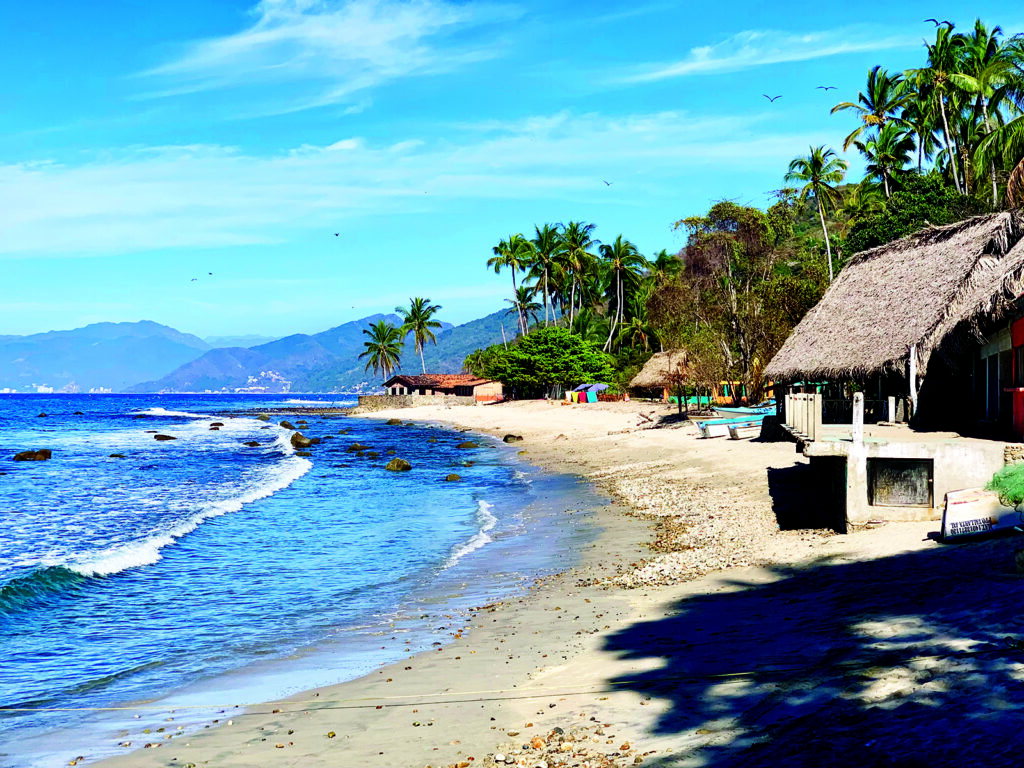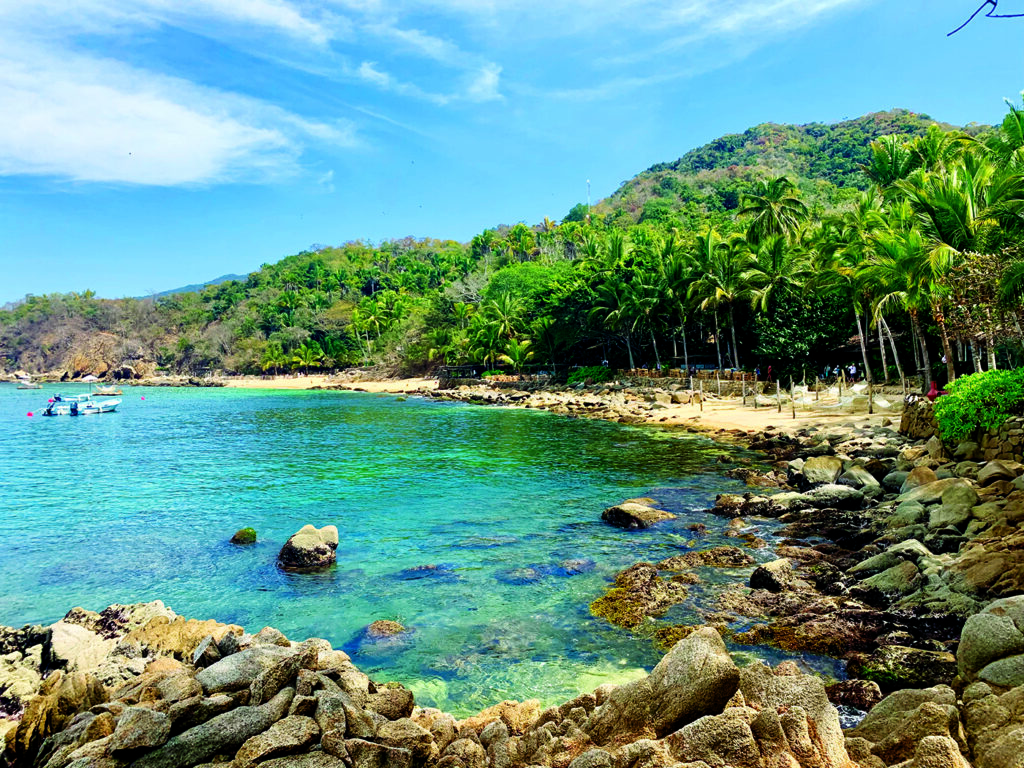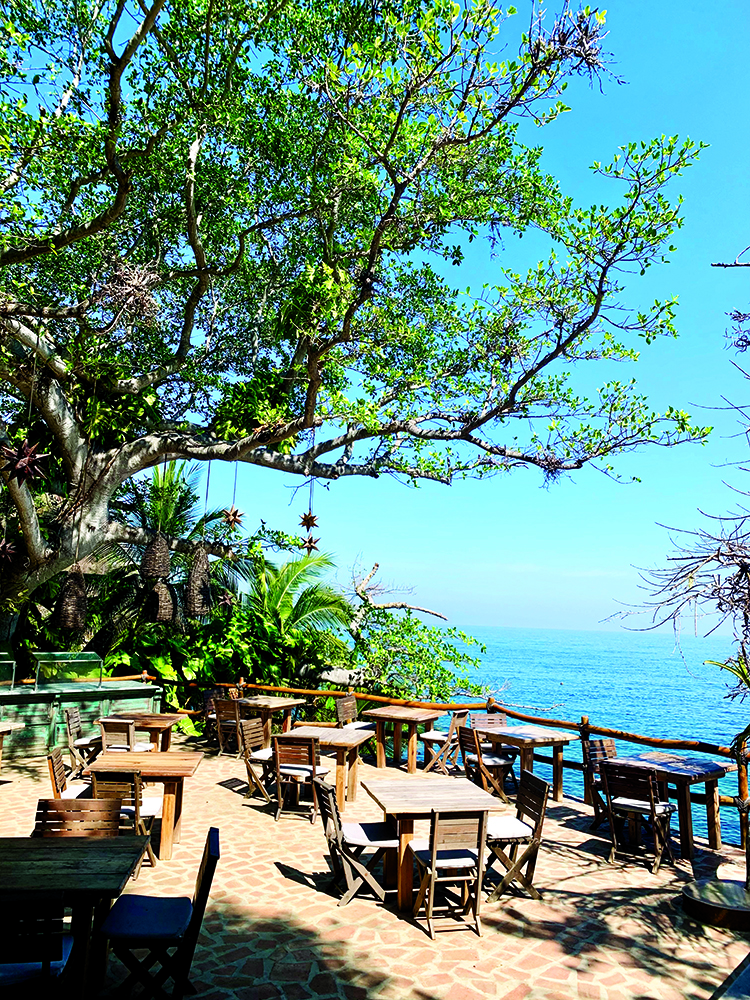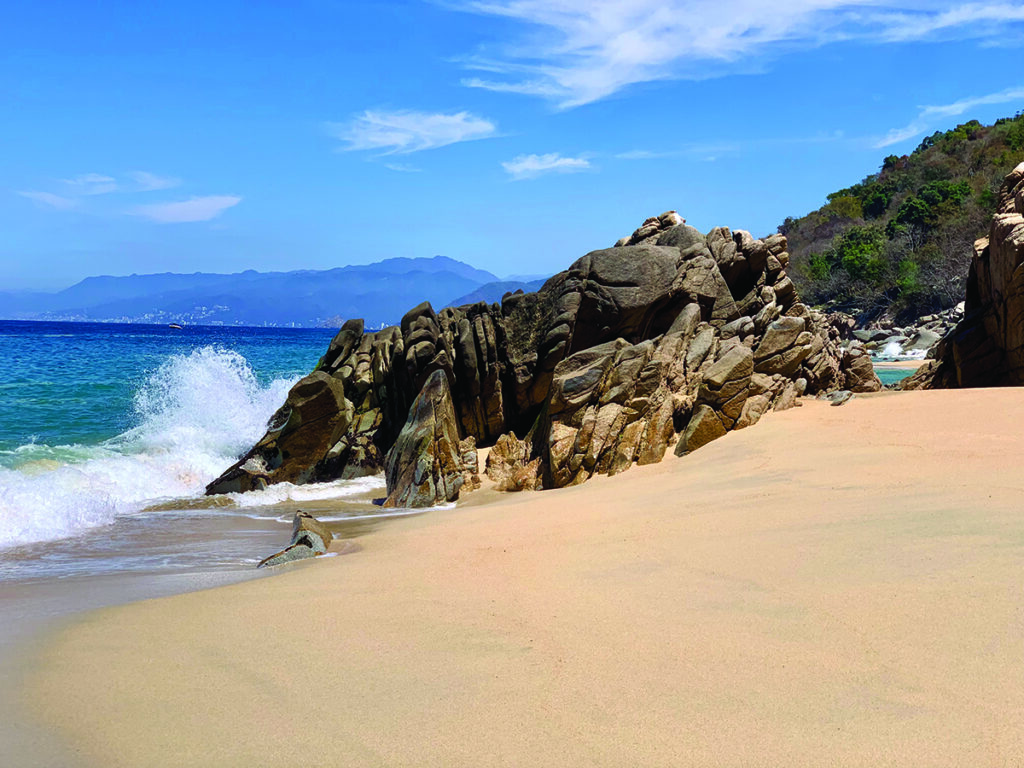 Even the most trivial things in Puerto Vallarta seem cosmopolitan. On the oceanfront Malecon, vendors sell tuba fresca, a non-alcoholic palm wine made from palm sap, ladled over ice out of a chilled barrel, garnished with nuts and fresh fruit (in this case, apple and pomegranate). Coconuts, however, are not native to Mexico’s Pacific Coast. They, like much else in the city, are a colonial introduction—both coconuts palms and the method for making tuba fresca and its alcoholic cousin were imported to Mexico from the Philippines when both were part of the Spanish Empire.
Even the most trivial things in Puerto Vallarta seem cosmopolitan. On the oceanfront Malecon, vendors sell tuba fresca, a non-alcoholic palm wine made from palm sap, ladled over ice out of a chilled barrel, garnished with nuts and fresh fruit (in this case, apple and pomegranate). Coconuts, however, are not native to Mexico’s Pacific Coast. They, like much else in the city, are a colonial introduction—both coconuts palms and the method for making tuba fresca and its alcoholic cousin were imported to Mexico from the Philippines when both were part of the Spanish Empire.
The area also has a long history of welcoming vacationers. As early as the 18th Century, as mining operations in the nearby mountains grew, Puerto Vallarta (until 1918 called Puerto Peñasco) was a popular place of respite for families in the surrounding mountains, as well as an important commercial port. It wasn’t until the 1960s when an international airport was completed that Americans began arriving, driving a tourist boom.
Today, even with decades of tourism growth, the city still has a laid-back, colonial feel. Built-up resorts dotting the beaches stretching to the north and south of town don’t seem to deposit large crowds into the town center itself, and the sparse walkers along the art-strewn Malecon are a pleasant mix of visitors and local residents. Perhaps it’s the mountains that the city development crawls directly up that have a compartmentalizing effect on the neighborhoods, making them feel smaller.
One of the neighborhoods is called Gringo Gulch, after a number of Americans took up residents in the 1950s and 1960s. Most famously, Elizabeth Taylor and Richard Burton bought two houses across the street from each other, and built a skybridge between them so they could visit each other without crossing the street and risking exposure to the paparazzi. The estate, Casa Kimberley, is today a boutique hotel, and guests in the Elizabeth Taylor suite will bathe in the same heart-shaped pink marble bathtub that Taylor custom-ordered for the property. A detail lost in translation returned a bathtub in the shape of the actual organ rather than the stylized heart shape that was requested.
 Nearby, travelers can book a table at La Capella to take in spectacular views of Banderas Bay and the baoque-styled crown atop the bell tower at Iglesia de Nuestra Señora de Guadalupe while strolling violinists serenade diners.
Nearby, travelers can book a table at La Capella to take in spectacular views of Banderas Bay and the baoque-styled crown atop the bell tower at Iglesia de Nuestra Señora de Guadalupe while strolling violinists serenade diners.
The owners of the restaurant also own and operate the BellView Hotel in the same building, so fans of the view can also book a room to enjoy it throughout their stay.
When it’s time to get out on the water, Vallarta Adventures operates catamaran excursions to Las Caletas, which was once the beachfront property of film director John Huston, who directed Elizabeth Taylor and Richard Burton in the 1964 film The Night of The Iguana, which was both set and filmed on location in Puerto Vallarta.
The voyage hugs the coastline, affording visitors views of the city and Los Arcos de Mismaloya—the famed rock arches just off the coast, which is a national park and sanctuary for nesting birds. Upon reaching Las Caletas, which seems sandwiched between rocky cliffs and the sea, there are numerous activities for guests to fill their day. Vacationers can swim, laze in oceanfront hammocks or beach chairs, take a ceviche cooking class, sample mezcal with chapulines (toasted grasshoppers), dive or snorkel—all with company from colorful parrots, flamingos, and accommodating staff.
Further down the rocky coast on the south of Banderas Bay is an area known as Cabo Corrientes, where the eco-resort Xinalani sits on a hill above a pristine beach. Focusing on wellness and yoga, the resort’s guest rooms have walls on three sides, leaving letting the sea breezes cool the rooms naturally. Accommodations range from deluxe private rooms to shared dormitories for budget travelers or those who want to travel in a communal group bubble.
 Guests spend their days attending yoga classes, taking massages at the resort’s spa suites perched in the rainforest just above the crashing surf on the beach, or dining in the communal dining room on local cuisine with vegetables from the on-site garden. Meals are included in the room rates; for luncheon guests might enjoy on freshly caught fish, roast chicken (the menu is vegetarian-friendly and avoids red meat), gazpacho, aguachile with shrimp and local mushrooms, brown rice pilaf tossed with local fruit and wine-poached pears.
Guests spend their days attending yoga classes, taking massages at the resort’s spa suites perched in the rainforest just above the crashing surf on the beach, or dining in the communal dining room on local cuisine with vegetables from the on-site garden. Meals are included in the room rates; for luncheon guests might enjoy on freshly caught fish, roast chicken (the menu is vegetarian-friendly and avoids red meat), gazpacho, aguachile with shrimp and local mushrooms, brown rice pilaf tossed with local fruit and wine-poached pears.
There’s also a beachfront bar, a small pool, and day beds and loungers dotting the sand stretching out between two rocky outcroppings on a wide stretch of sandy beach.
When not spending time on the beach or bathing in the ocean, there’s time to explore the nearby town of Quimixto, where they’ll find oceanfront bars and restaurants—and the main sources of transport are donkeys. The town is entirely off the road system, so goods and guests all arrive via boat from Puerto Vallarta or water taxi to the nearby highway.
While many luxury resorts tend to cluster in the Puta Mita Area about 45 minutes north of the airport, many of the global hospitality brands have upper upscale resorts delivering the gracious, heartfelt service Mexico is renowned for. In the Marina Vallarta area, just ten minutes from the Malecon by car, the Westin Resort & Spa Puerto Vallarta sits on oceanfront property with towering heritage palms and throwback architecture—think open-air spaces flanked by concrete columns, polished marble floors, and oversized guest rooms with distinctive local flair in furnishings—like rustic found woods and decorative tile.
 A more intimate, adults-only option in Marina Vallarta is the Casa Velas. Located on the Joe Finger-designed 18 hold Marina Vallarta golf course, this all-inclusive sister property to the beachfront Velas Vallarta offers seclusion and privacy, along with access to the amenities and services of the larger resort. Guests can relax at the resort’s intimate pool or tranquil indoor-outdoor restaurant or take a free shuttle to the higher-energy Tau Beach Club on Pelicanos Beach. Guest rooms include L’Occitane bath amenities and minibars stocked with snacks, premium liquors, and Mexican brand beers.
A more intimate, adults-only option in Marina Vallarta is the Casa Velas. Located on the Joe Finger-designed 18 hold Marina Vallarta golf course, this all-inclusive sister property to the beachfront Velas Vallarta offers seclusion and privacy, along with access to the amenities and services of the larger resort. Guests can relax at the resort’s intimate pool or tranquil indoor-outdoor restaurant or take a free shuttle to the higher-energy Tau Beach Club on Pelicanos Beach. Guest rooms include L’Occitane bath amenities and minibars stocked with snacks, premium liquors, and Mexican brand beers.
There’s plenty of shopping in the resorts and along the Malecon, but perhaps the most distinctive souvenir one can take home from Puerto Vallarta is a piece of Huichol bead art. This art form originates with the indigenous Huichol people of the Sierra Madre of northern Nayarit, Jalisco, and western Zacatecas, and involves intricate beading and yarn wrapping around a wood carving, typically of an animal figure.
Shopkeepers can explain some of the intricacies of the designs (the woven patterns typically have significance in the indigenous religion) and some of the shops will even host some of the artists in residence for demonstrations or to answer questions.
Whether visitors to Puerto Vallarta choose to fill their days with exploration, or have nothing on their itinerary beyond a beach or pool chair and beverage orders, this charming city on Mexico’s Pacific coast offers a supremely elevated experience in this intoxicatingly friendly country.
By Scott Laird